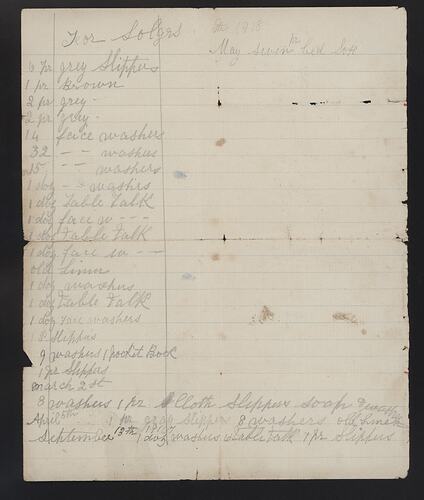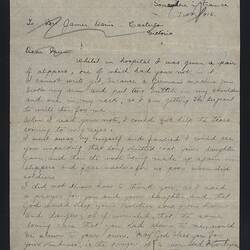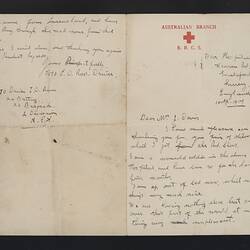Summary
Lined sheet of note paper listing the items made for, or sent as gifts to, soldiers during World War I by a Mrs J. Davis. She lists grey and brown slippers, face washers, linen and 'old linen', a pocket book, soap and 'Table Talk' (presumably Table Talk magazine, which had been published since 1885 and was intended for both male and female audiences).
Three other items within the Museum's collection also relate to Mrs Davis (HT 30546, HT 30547 and HT 30548): letters of thanks from some of the soldiers who received her gifts. From these letters come her address in Casterton, Victoria, and also her husband's name since one of the letters is addressed to 'Mrs James Davis.' This letter also makes reference to Mrs Davis' sons, who are also serving in the Australian Imperial Forces, as well as a daughter who has helped her to make the items.
The identity of Mrs Davis is suggested from several sources. The 1914 and 1919 census records list four women living in Casterton, Victoria with the surname 'Davis'. Of these women the most likely contender for the Mrs Davis referred to in the letters is 'Kate Davis'. A Catherine Walsted (sometimes referred to in the records as 'Kate') married a James Davis in 1873. The couple had several children including three sons who served in the AIF during World War I and a daughter. Catherine Davis (nee Walsted) died in 1950 and was buried in the Castlemaine Cemetery.
Physical Description
Single sheet of discoloured, lined notepaper. The page has three hand drawn columns in pencil with a hand written list of items and their quantities, also in pencil. The page shows signs of being folded into four. A deep crease runs across the centre of the page along with a small hole in the centre where the page has worn away. There is further loss along two other creases as well as the two side edges of the page. The page also has foxing and two small ink stains.
Significance
The International Committee of the Red Cross was initially established to improve the medical facilities of the army in order to provide better care for wounded soldiers. The Australian Red Cross Society (ARCS) was established in 1914 as a branch of the British Red Cross Society and was active throughout World War I in providing 'comforts' to the troops.
For the most part 'comforts' took the form of homemade articles of clothing donated by thousands of women volunteers; however other items such as food, magazines and other provisions were also distributed by the ARCS. An estimated 395,695 food parcels and 36,339 clothing parcels were sent by the ARCS during World War I.
The items in this small collection relate to the efforts of one woman, Mrs. James Davis, to support the Australian Red Cross and three letters that she received from soldiers who received her items. These letters are significant as they show the gratitude of the soldiers for the 'comforts' that they received from home and their importance. One letter in particular expresses the profound impact such gifts could have upon soldiers since they showed the support and care, not only of their own families, but of the wider Australian community.
The record of Mrs. Davis' creations is impressive in terms of the quantity of items produced by an individual in only a few months. Whilst the list is significant as an example of the dedication of the volunteers who supported the ARCS and how this support became an industry in its own right.
All together this collection of objects provides a rare surviving example of home front activity during World War I.
More Information
-
Collecting Areas
Clothing & Textiles, Public Life & Institutions, Home & Community
-
Acquisition Information
Transfer from Strategic Collection Management, Collections, Research & Exhibitions, Museum Victoria, 20 Jan 2012
-
Author
-
Inscriptions
Hand-written in pencil along the top margin: 'For Solgrs; 6th 1918 / May [ie the month?] Seven pr bed Sox [?]' Hand-written in pencil in hand drawn columns as the main test: list of items and their quantities
-
Classification
-
Category
-
Discipline
-
Type of item
-
Overall Dimensions
191 mm (Width), 235 mm (Height)
-
Keywords
World War I, 1914-1918, Handcrafts, War Effort, Soldiers' Comforts




